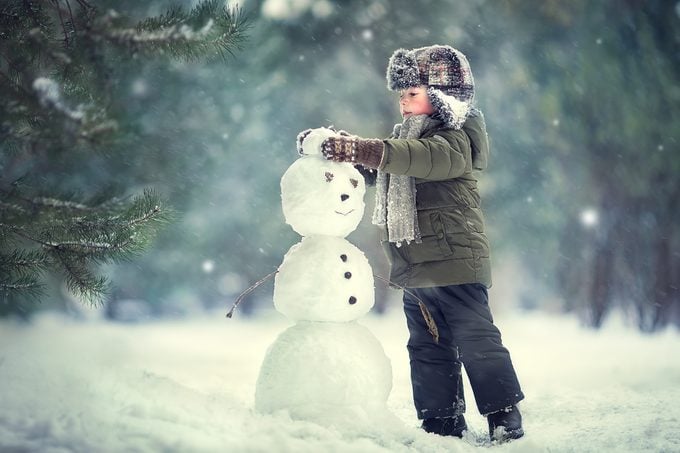The Fascinating History of the Snowman
Updated: Nov. 04, 2022
Miracles, massacres, and Michelangelo; see how snowmen had a frosty hand in them all.

The snowman is like a frozen Forrest Gump—look to many of history’s cultural benchmarks, and there you’ll find a forebear of Frosty. It was a snowman who appeared on some of the first postcards, starred in some of the initial silent movies, and was the subject of a couple of the earliest photos, dating all the way back to the 1800s. I discovered even more about one of humanity’s earliest forms of folk art during several years of research around the world.
For example, snowmen were a phenomenon in the Middle Ages, built with great skill and thought. At a time of limited means of expression, snow was like free art supplies dropped from the sky. It was a popular activity for couples to stroll through town to view the temporary works of chilly art. Some were created by famous artists, including a 19-year-old Michelangelo, who in 1494 was commissioned by the ruler of Florence, Italy, to sculpt a snowman in his mansion’s courtyard. Follow these tips to build the perfect snowman.
The Miracle of 1511 took place during six weeks of subzero temperatures called the Winter of Death. The city of Brussels was covered in snowmen—a spectacular tableaux that told stories on every street corner. Some were political in nature, angry swipes at the church and government. Some were downright pornographic. For the people of Brussels, this was their Woodstock, a defining moment of artistic freedom. At least until spring arrived, by which time the Belgians were dealing with damaging floods.
Snowmen also played a part in one of the bloodiest events in early American history, the Schenectady Massacre of 1690. At the time, Fort Schenectady, in what is now upstate New York, was a remote Dutch settlement under constant threat of attack. But the soldiers guarding the gates, which were frozen open, left a pair of snowmen at their post to protect the town when they left to get out of a blizzard. Unknown to them, a contingent of 210 French Canadian soldiers and Native Americans were approaching. Having traveled over three weeks in knee-deep, slushy snow, they were unfazed by the snowmen and invaded the fort, killing 60 villagers.
If you fear the heyday of the snowman has passed, don’t worry: I’ve learned that some explosive snowman history is still being made today. Every year since 1818, the people of Zurich, Switzerland, celebrate the beginning of spring by blowing up a snowman. On the third Monday of April, the holiday Sechseläuten is kicked off when a cotton snowman called the Böögg is stuffed with dynamite and paraded through town by bakers, blacksmiths, and other tradesmen who throw bread and sausages to the crowds. The parade ends with the Böögg being placed on a 40-foot pile of scrap wood. After the bells of the Church of St. Peter have chimed six times, representing the passing of winter, the pile is lit. When the snowman explodes, winter is considered officially over—the shorter the combustion, the longer summer is said to be.